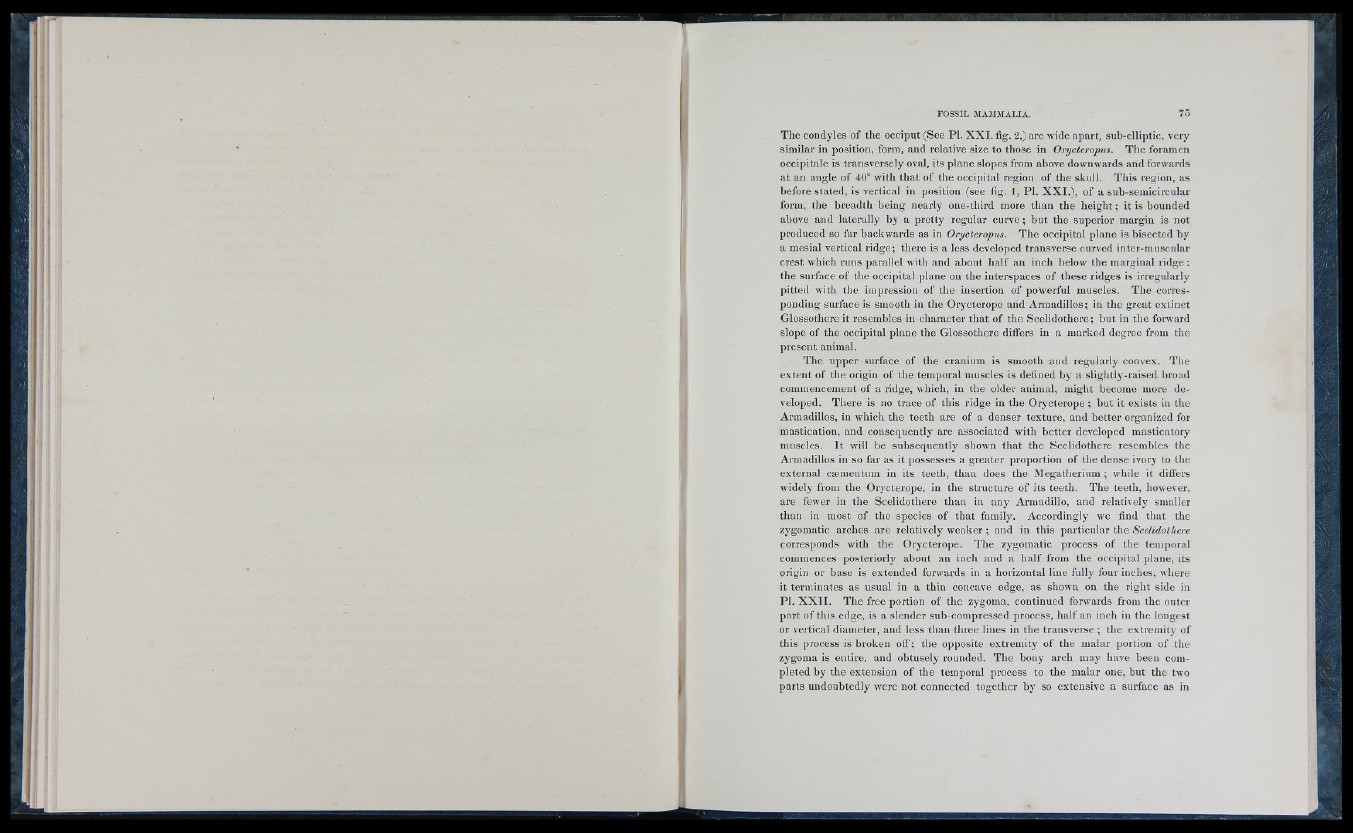
The condyles o f the occiput (S e e PI. X X I . fig. 2 ,) are wide apart, sub-elliptic, very
similar in position, form, and relative size to those in Orycteropus. T he foramen
o ccipitale is transversely oval, its plane slopes from above downwards and forwards
at an angle o f 40° with that o f the occipital region o f the skull. Th is region, as
before stated, is vertical in position (see fig. 1, PI. X X I .) , o f a sub-semicircular
form, the breadth being nearly one-third more than the height ; it is bounded
above and laterally by a pretty regular curve ; but the superior margin is not
produced so far backwards as in Orycteropus. The occipital plane is bisected by
a mesial vertical ridge; there is a le ss developed transverse curved inter-muscular
crest which runs parallel with and about h a lf an inch below the marginal ridge :
the surface o f the occipital plane on the interspaces o f these ridges is irregularly
pitted with the impression o f the insertion o f powerful muscles. The corresponding
surface is smooth in the Orycterope and Armadillos; in the great ex tinc t
Glossothere it resembles in character that o f the Scelidothere; but in the forward
slope o f the occipital plane the Glossothere differs in a marked degree from the
present animal.
The upper surface o f the cranium is smooth and regularly convex. The
ex ten t o f the origin o f the temporal muscles is defined by a slightly-raised broad
commencement o f a ridge, which, in the older animal, might become more d e veloped.
There is no trace o f this ridge in the Orycterope ; but it ex ists in the
Armadillos, in which the teeth are o f a denser texture, and better organized for
mastication, and consequently are associated with better developed masticatory
muscles. It will be subsequently shown that the Scelidothere resembles the
Armadillos in so far as it p o ssesses a greater proportion o f the dense ivory to the
external cæmentum in its teeth, than does the Megatherium; while it differs
widely from the Orycterope, in the structure o f its teeth. The teeth, however,
are fewer in the Scelidothere than in any Aniiadillo, and relatively smaller
than in most o f the spe cie s o f that family. Accordingly we find that the
zygomatic arches are relatively weaker ; and in this particular the Scelidothere
corresponds with the Orycterope. The zygomatic process o f the temporal
commences posteriorly about an inch and a h a lf from the occipital plane, its
origin or base is extended forwards in a horizontal line fully’^ four inches, where
it terminates as usual in a thin concave edge, as shown on the right side in
PI. X X I I . The free portion o f the zygoma, continued forwards from the outer
part o f this edge, is a slender sub compressed process, h a lf an inch in the longest
or vertical diameter, and le ss than three lines in the transverse ; the extremity o f
this process is broken off ; the opposite extremity o f the malar portion o f the
zygoma is entire, and obtusely rounded. The bony arch may have been completed
by the extension o f the temporal process to the malar one, but the two
parts undoubtedly were not connected together by’ so ex tensiv e a surface as in